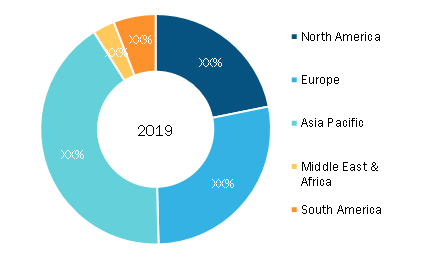According to our latest market study on “Irrigation Automation Market Forecast to 2027 –COVID-19 Impact and Global Analysis - by Automation Type (Time-Based Systems, Volume-Based Systems, Real-Time Feedback Systems, Computer-Based Irrigation Control Systems); Irrigation Type (Drip Irrigation, Sprinkler Irrigation, Surface Irrigation); Component (Controllers, Sensors, Valves, Sprinklers, Others); System (Automatic, Semiautomatic); and End-user (Agricultural, Non-Agricultural), and Geography,” the market was valued at US$ 2.47billion in 2019 and is projected to reach US$ 9.63 billion by 2027; it is expected to grow at a CAGR of 19.2% from 2020 to 2027.
Automated irrigation systems work with minimal manual intervention. Various types of irrigation, such as drip, sprinkler, and surface irrigation, are being converted into automated systems with the help of sensors, timers, and mechanical appliances. The automation of existing irrigation process makes the entire agricultural activities more efficient as well as supports the farmers and growers to conserve water and energy. To alter the frequency of irrigation and fertigation processes, power on/off of irrigation process is required, which results in optimizing energy requirements, and the system can be operated anytime resulting in minimal water loss are some of the benefits of advanced irrigation systems which makes them adaptable among the farmers. The irrigation systems are automated into time-based systems, volume-based systems, open-loop systems, closed-loop systems, real-time feedback systems, and computer-based irrigation control systems that make agricultural activities more efficient.
Several governments worldwide are supporting the installation of irrigation automation systems owing to the rising issue of scarcity of water. For instance, the Australian government has initiated several R&D projects to enhance water usage efficiency. Moreover, the government has introduced the On-farm Irrigation Efficiency Program to support individual irrigators to enhance their irrigation infrastructure or change irrigation practices to save water. Some of the practices include installation of automatic gates or outlets and water metering, as well as the use of telemetry systems. Recently, the Australian government offered weather smart irrigation rebate for Perth residential customers. The rebate offered was up to ~ US$ 142, and it was primarily meant for the purchase and programming of entitled weather smart irrigation products.
Based on geography, APAC holds a significant share of the irrigation automation market, and North America is expected to register a high CAGR during the forecast period. The top companies operating in the field of irrigation automation include Jain Irrigation Systems Ltd.; Lindsay Corporation; Nelson Irrigation Corporation; Rubicon Water; The Toro Company; Valmont Industries, Inc.; Galcon; Hunter Industries; Irritec S.P.A; and WaterBit, Inc. Various market players are coming up with advance irrigation automation solutions, thereby fueling the growth of the irrigation automation market.
Impact of COVID-19 on Irrigation Automation Market
The COVID-19 crisis is affecting the industries worldwide and the global economy is on the verge of taking the worst hit in 2020, and the impact is likely to persist in 2021 as well. The outbreak has created significant disruptions in primary industries, such as manufacturing, construction and infrastructure, energy & power, electronics & semiconductors, and automotive, among others. This has also affected the irrigation industry as the spread of virus continues to leave far-reaching impacts on the water–energy ecosystem. Moreover, fiscal constraints, lacking labor availability, and supply chain interruptions caused by travel bans are among other factors adversely limiting the water irrigation business. In addition, the manufacturing of smart irrigation systems is also getting impacted due to temporary shutdown of manufacturing facilities. Although the irrigation agencies are looking forward to continue with their operations despite the challenging scenario, small farmers are vulnerable to the challenges presented by the pandemic. In regards to the market for agricultural production & distribution systems, the irrigation sector is observing negative results. Thus, the difficulties in carrying out agriculture activities and imposition of lockdown are restraining the supply of irrigation systems worldwide, thereby affecting the overall irrigation automation market.
Irrigation Automation Market — Geographic Breakdown, 2019

Irrigation Automation Market Dynamics and Analysis by 2031
Download Free Sample
Irrigation Automation Market Size and Forecast (2021 - 2031), Global and Regional Share, Trend, and Growth Opportunity Analysis Report Coverage: By Automation Type (Time-Based Systems, Volume-Based Systems, Real-Time Feedback Systems, and Computer-Based Irrigation Control Systems); Irrigation Type (Drip Irrigation, Sprinkler Irrigation, and Surface Irrigation); Component (Controllers, Sensors, Valves, Sprinklers, and Others); System (Automatic and Semiautomatic); End-user (Agricultural and Non-Agricultural); and Geography
Irrigation Automation Market Dynamics and Analysis by 2031
Download Free SampleIrrigation Automation Market Size and Forecast (2021 - 2031), Global and Regional Share, Trend, and Growth Opportunity Analysis Report Coverage: By Automation Type (Time-Based Systems, Volume-Based Systems, Real-Time Feedback Systems, and Computer-Based Irrigation Control Systems); Irrigation Type (Drip Irrigation, Sprinkler Irrigation, and Surface Irrigation); Component (Controllers, Sensors, Valves, Sprinklers, and Others); System (Automatic and Semiautomatic); End-user (Agricultural and Non-Agricultural); and Geography
The report segments the global irrigation automation market as follows:
By Automation Type
- Time-Based Systems
- Volume-Based Systems
- Real-Time Feedback Systems
- Computer-Based Irrigation Control Systems
By Irrigation Type
- Drip Irrigation
- Sprinkler Irrigation
- Surface Irrigation
By Component
- Controllers
- Sensors
- Valves
- Sprinklers
- Others
By System
- Automatic
- Semi-Automatic
By End User
- Agricultural
- Non-Agricultural
By Geography
- North America
- US
- Canada
- Mexico
- Europe
- France
- Germany
- Italy
- UK
- Russia
- Rest of Europe
- Asia Pacific (APAC)
- China
- India
- South Korea
- Japan
- Australia
- Rest of APAC
- Middle East and Africa (MEA)
- Saudi Arabia
- UAE
- South Africa
- Rest of MEA
- South America (SAM)
- Brazil
- Argentina
- Rest of SAM